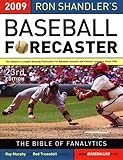Ron Shandler’s Baseball Forecaster 2009
Let the record show that I am not a fantasy baseball participant: I have only participated in one such league, and it was a season long home run derby. I think I finished third or fourth, if it’s of any consequence to you. I’ve only participated in one other fantasy venture – a hockey league that I drafted my players and promptly forgot about it. I don’t even know where I stand in that league.
While I don’t participate in fantasy sports, I certainly appreciate the analysis and insight that those who do have brought to the table for discussion. When you are serious about the league you are playing in, and by serious I mean willing to put money out on your predictions, you want the best information as possible.
That is what Ron Shandler and his crew are trying to deliver, and is what they once again succeed at doing, of course with the all important disclaimers.
When I spoke with Mr. Shandler last year about his 22nd edition, he was careful to remind all of us that right now, the best projection systems are only able to achieve about 70% accuracy. That number is still in effect with the 23rd edition, so bear in mind that there is still a fairly large amount of space that can’t be nailed down.
Along with that, it’s tough to be critical of the projections that the book puts forth because we won’t know their accuracy until after the season, which isn’t the best time to put out a review of a book such as this. So I’m leaving the projection side alone, and focusing on the commentary and analysis portions of the book, which I find to be the real juicy parts and the ones that almost any fan can get into, regardless of whether or not they participate in fantasy baseball.
For me, the first 50 pages of the 271 in the book are where the goodies lie – Shandler and his contributors do a remarkable job explaining their thoughts and strategies in a way that makes it easy to understand and gives the reader an understanding of the trends that shape player performance and valuation.
If anything, the book is brutally honest – case in point, The Gravity Principles, mentioned on page 23, which basically state that it is incredibly hard to be good, and that all levels of success are susceptible to disappearing at any time. Likewise, it’s much harder to get yourself out of a slump than it is to maintain a level of success.
The Baseball Forecaster also establishes age and performance markers that help you really see if a prospect or player is worth picking up or not. Having crunched the data on thousands of players over many, many years, they have developed a fairly accurate way to look at a player and see what he might be capable of. Again, by no means a definitive set of criteria, but something that does provide a guide tempered by historical research.
As I read the book, I began feeling that I could make the argument that this is as much a life philosophy title as it is a baseball book focusing on fantasy projections. It strips down the task of trying to predict player performance to looking at “component skills analysis,” a much easier thing to wrap your head around.
Which is why I enjoy the book so much – while it deals in statistics and projections, it maintains a level of approachability that other books don’t. It also manages to throw in a good amount of humor – some laugh out loud funny, some not – but it manages to keep the book from getting too heavy. Instead of just being page after page of numbers, it helps you look at the traits a player exhibits, both good and bad, and how that fits into his makeup and thus affects his performance.
Using a good amount of well-known players as examples, they clarify the concepts even further, something that will be appreciated by those both familiar with fantasy baseball and those just wanting a better understanding of how players get valued for what they bring to the park everyday.
The Baseball Forecaster 2009 presents the opportunity for any fan who wants to better understand the performance side of baseball to do just that, and in a format that should keep you engaged while not bogging you down with too many numbers. Not to say that there aren’t a good amount of stats and terms put forth – but think of it like this: remember when you had to take a class in college that was taught by several professors? You’d ask your friends which professor made the material more enjoyable, and you tried to get his or her class. The same goes with this – Professor Shandler and his book make player valuation an approachable subject for those who might otherwise be intimidated by it, while keeping his credibility with his upper-level students who want more information and knowledge.
Shandler asks you to leave antiquated statistics like ERA and batting average behind in favor of looking at performance rates – but he doesn’t expect you to make the jump on your own. The explanation for his requests are always present, and his rationale is clear. If you’re still looking at the scoreboard to see what a guy is hitting or how many wins the starting pitcher has, this will be a bit of a departure for you, but the net is never taken away; you’re just reminded why you won’t need it.

